Welcome to a new issue of the Journal of Runic Studies, the premier Malkioni publication for studies into the nature of Glorantha. If you haven’t subscribed yet, please consult with the spirit bound to the appropriate electronic page.
God Learner Sorcery
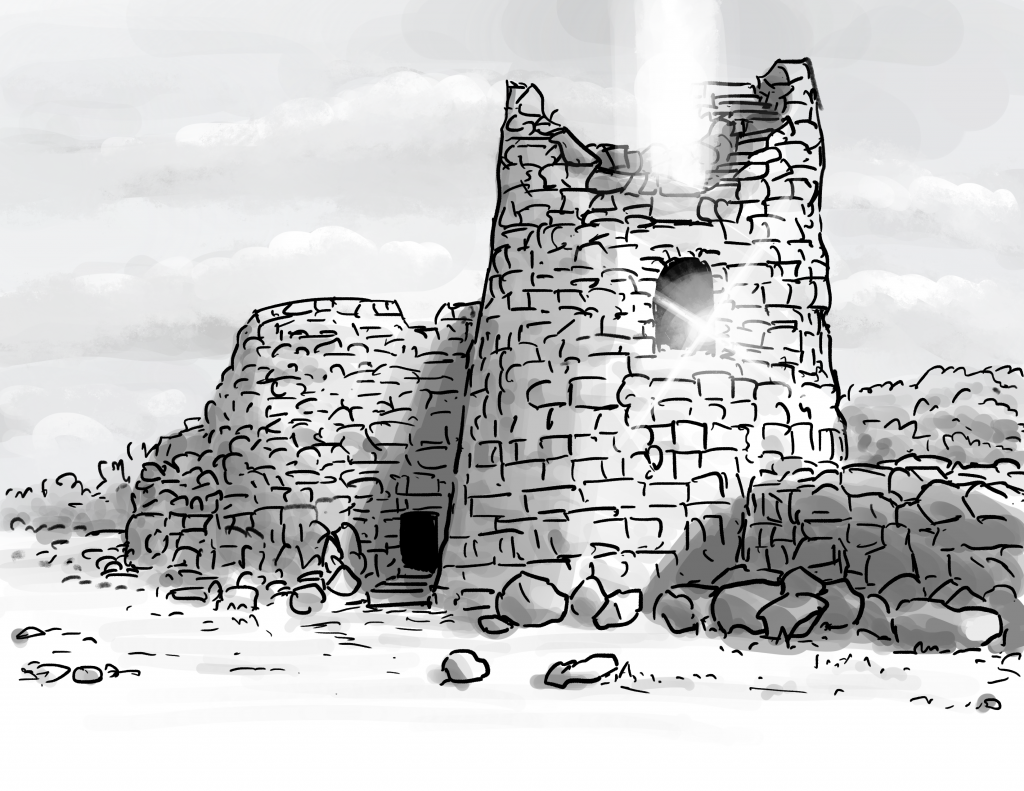
Here is what us God Learners were up to this week.
Episode 15: People of Glorantha: The Tusk Riders
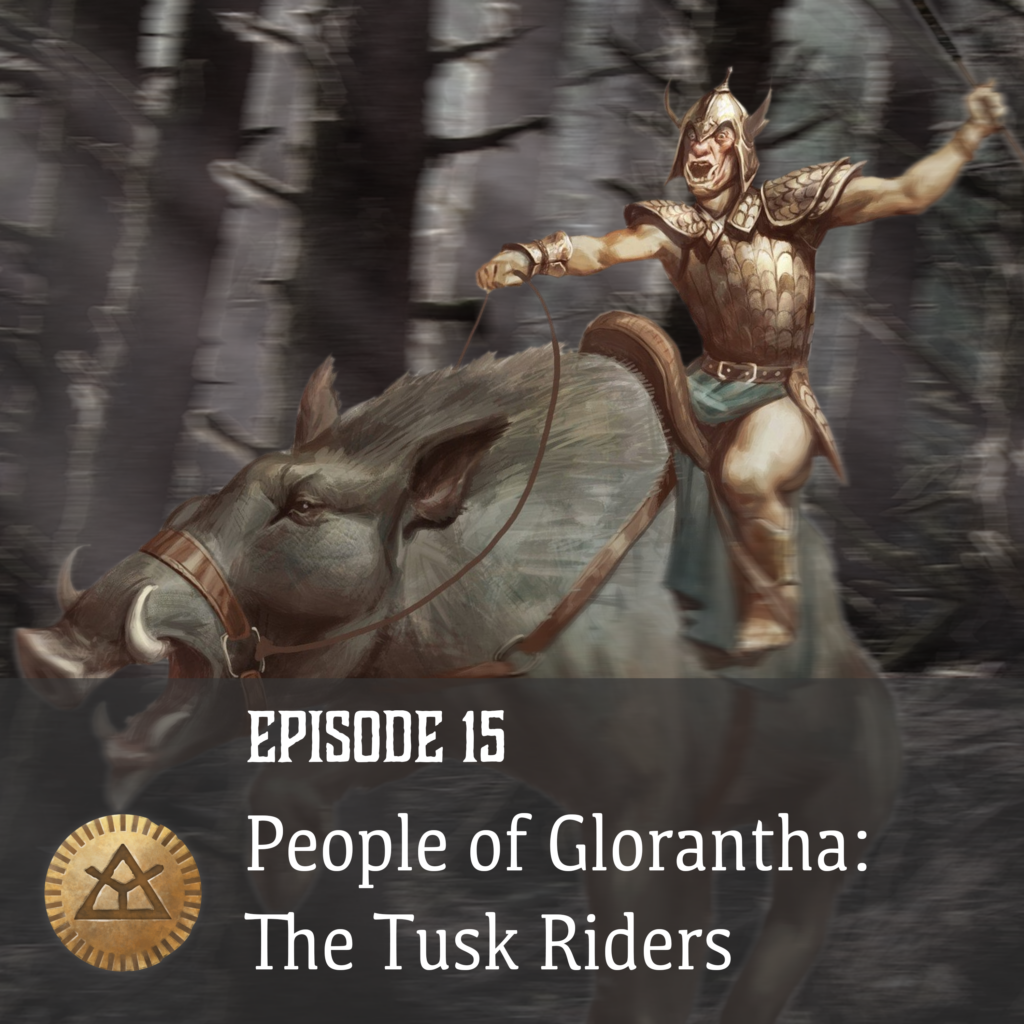
Episode 15 of the God Learners welcomes Dom Twist to talk about the best bad guys of Glorantha: the Tusk Riders! We discuss their publication history, what PCs and NPCs might know them, their secret origin, how to use them in your RuneQuest campaign, and more!
Chaosium News

Here are this week’s Chaosium news!
Update on Upcoming Projects
We very recently had such an update from Rick Meints, but here’s a more recent one from Jason Durall, line editor for RuneQuest (among his many other hats):
Cults of Glorantha + Prosopaedia
Rune and Spirit Magic Spell Decks
Sartar
The Guide to Dragon Pass
Gamemaster Sourcebook
Mythic Iceland – using RQ rules but not set in Glorantha
The Dragon Pass Campaign
Jonstown Adventures (title may change, this is a followup to the Starter Set)
Elder Race Adventurers
The Upland Marsh
Adventurer’s Journal
The Dreaming Ruin (another adventure anthology)
The Hunt for the Storm Calf (a one-off adventure based off Khan of Khans)
Prax
Into the Troll Realms
Sun Dome Temple sourcebook
Return to Snakepipe Hollow
The Dragon’s Eye
Big Rubble
Pavis
The Culbrea Tribe
Elfpack
Heortland & Hendrikiland
HeroQuesting
Nochet & Esrolia
Kralorela
The Siege of Whitewall
“The Great Wagon Train Campaign” (title TBD)There are at least five other books I am either not sure I can speak about, or might need to be re-assigned, but are definitely planned. I can’t give a schedule because so many things are outside my control.
The entire post was reposted on BRP Central by David Scott (thanks David!) so you can check it out and discuss it there if you’re not on Facebook. A lot of these projects had already been mentioned before, but I think this is the first time I hear about “Jonstown Adventures”, “Adventurer’s Journal”, “The Siege of Whitewall” and “The Great Wagon Train Campaign”. It’s nice to have names for the next adventure collections, too.
RuneQuest Miniatures, Rick Meints Edition
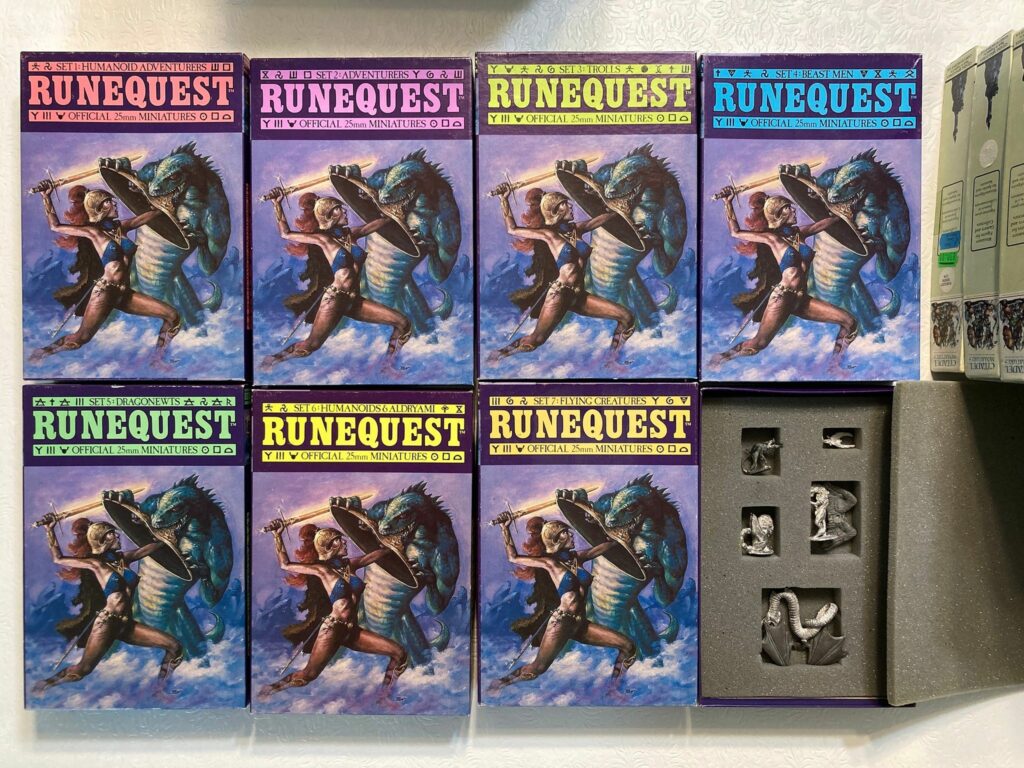
Rick Meints has another “Out of the Suitcase” article on the Chaosium blog which takes a deep look at some old RuneQuest miniatures, and the small scenario booklets that sometimes came with them… Rick even generously provides high-resolution enough photos of these booklets that you can read them and run the adventures therein… thanks Rick!
RPG Writer Workshop Adventure Bundles
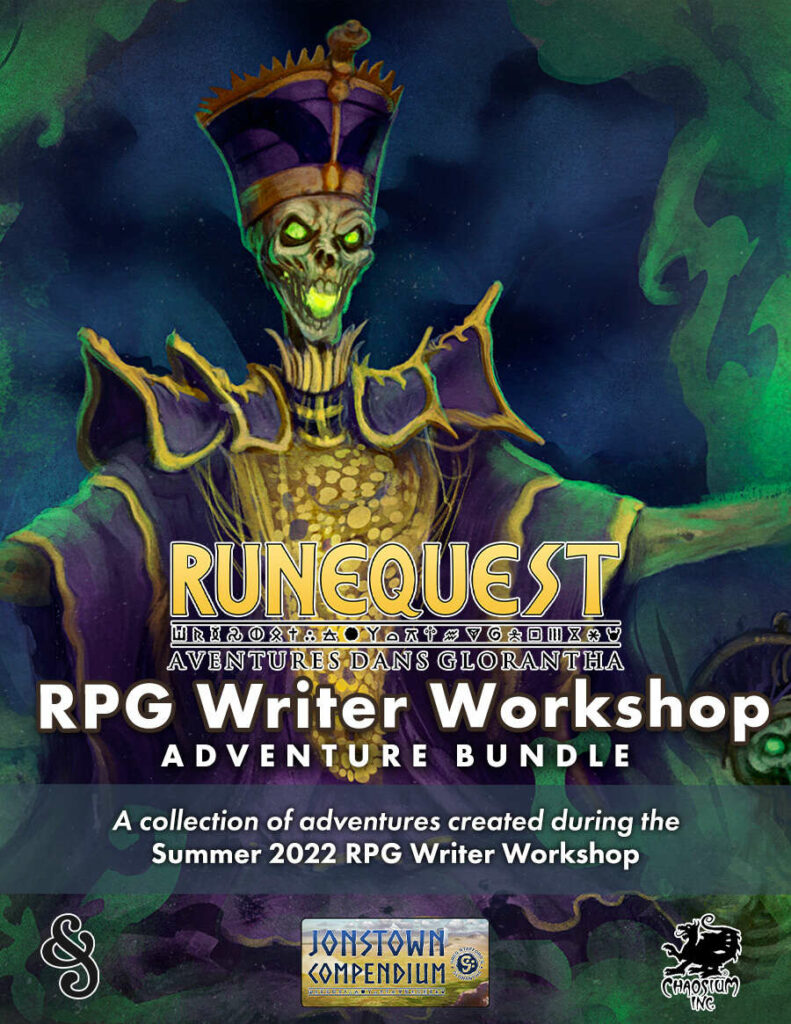
The Summer 2022 RPG Writer Workshop is now finished, and a few of the participants published their work on the Miskatonic Repository and the Jonstown Compendium (for Call of Cthulhu and RuneQuest, respectively, of course).
Chaosium has made two handy bundles collecting these PDFs. The RuneQuest bundle is here, and the Call of Cthulhu bundle is here.
The White Bull Campaign S03E05
The campaign continues… you know the drill!
Jeff’s Notes

Jeff Richard, the current mastermind on everything Gloranthan at Chaosium, is often posting notes and thoughts on the RuneQuest Facebook group. Here’s our curated list from the past week. A partial archive of these sources is compiled on the Well of Daliath.
A Brithini Tale
If you’re interested in immortal Malkioni sorcerers, this “Brithini tale” sort of acts as a founding myth for them.
For those who don’t know what the Brithini are, they’re basically western sorcerers who achieve immortality by clinging to super old traditions dating back to the God Time. Back then everybody was immortal and, supposedly, the One, Malkion the Creator, the Invisible God, whatever you call the original conscience of existence, was making everybody happy and logical. But, according to this tale, a mathematically dubious entity started splitting things and making things different, and things went downhill from there.
In the Gods Age all was perfect. and nothing in the world ever died. All beings were gods. Law oversaw all. Prosperity reigned in the Kingdom of Logic.
Logic demands that all beginnings have an end. What was started must be finished. From the moment of the first mathematical evolution of One into Two the end was destined to come. The division of one into Two made the Creator and Destroyer. A choice was given, and we chose the One. If alI the world had chosen One we would exist in harmony still.
Two is the Destroyer, who can make Three out of Two, Four out of Three, and Five out of Four. The Destroyer seduced half of One, and brought it to imperfection. The Destroyer inhabited half of One, and brought it to death.
Do you need to justify spending all your week-ends at home, never agreeing to parties and road trips and checking out this new brewery/pub that opened downtown? Now you can! Just say that you are honouring the ancestral traditions of the Brithini in order to achieve immortality and logical union with The One! I’m sure your friends will understand:
When Zzabur asked his father “How do we stay immortal?” the Prophet answered simply. He said. “Do not change. Do what you have done. Act within the Laws and Ways you have been given, for they are immortal. Your actions embody the One, your bodies enact the One. Anything new from this moment forward is Death.”
More here, including how the Brithini hate the Hrestoli (a Malkioni sect that favours self-care, personal journeys, and caste mobility), and how the Brithini still accept the divine monomyth as true (it’s just that they think gods are jerks, and their worshippers are suicidal fools).
Draconic Philosophy
Do you want more deep-cut Gloranthan world views? Here is a note on “Draconic Philosophy“, and is by and large the same text you’ll find in Wyrms Footnotes #14 as part of the overall “Dragon Pantheon” article, and parts of this text also ended up in the Glorantha Sourcebook’s chapter on the “Draconic Creation Myth”.
The Cosmic Egg hatched and from it came the Grand Ancestral Dragon. It sat and meditated in the Silent Void, treasuring the secrets of the universe. The halves of the eggshell were made into the servants of the Grand Ancestral Dragon and were called the Inside and the Outside.
A little bit of context: the Cosmic Egg didn’t appear from nowhere — it was somewhat hatched by the Cosmic Dragon. You may have already seen the “Ouroboros poem” which somewhat describes the creation of the universe in the draconic myths:
– : Silence, The Infinite.
0 : Zero, or an exclamation.
OU : A cry of pain; Ego.
OUR : Collectiveness, plurality.
OURO : Collective emptiness.
OUROB : Creation (Collective with an end-stop ‘b ‘).
OUROBO : Closed Infinity, or Being.
OUROBOR : Birth.
OUROBORO : Nothing, emptiness.
OUROBOROS : S = ‘Voice’ (i.e. the sound a serpent makes).
Okay so the Cosmic Dragon is often considered to be the “S” at the end of the poem. It comes out of this vague self-emergent Ouroboros thing, which is possibly just the first thought. The Cosmic Dragon then gets bored and starts doing stuff, including fighting a six-limbed no-headed monster called Orxili, which is possibly a manifestation of Chaos. Anyway, the Cosmic Dragon “set forth the Six Principles and with each recitation one of the monster’s limbs was torn off and cast into emptiness“. The Cosmic Dragon set put Orxili at the centre of the world, spun around Superman-style, and made the Cosmic Egg out of it… which, err, sort of means the Cosmic Egg was made of Chaos. Someone should tell that to the Broken Council and to Nysalor maybe?
Anyway, now you know what Jeff is talking about when he mentions the “six actions” (which are possibly acted upon based on the six principles?), or when some of Orxili’s limbs come back and fight the Great Ancestral Dragon:
The Grand Ancestral Dragon was committed to six actions which it voluntarily undertook. Each these resulted in the creation of one of the Ancestral Dragons.
[…]
Either during or shortly after this time the Grand Ancestral Dragon was assailed by powerful enemies. Some of the limbs torn from Orxili had returned. The mild waves of Disorder lapped back from the Void and the Oozing Chaos was born, returning now to thwart creation and reclaim its own to the void.
Next, the Great Ancestral Dragon performs “utuma“, the draconic ritual suicide that is still performed by Dragonewts to this day. In the case of the Great Ancestral Dragon, his blood and guts and such create a bunch of things like the ocean and the earth and so on. He has to do it because these things exists, and it’s his responsibility to create them because they are already created. Or something. It’s this whole idea of causal loops and “entanglements” that draconic mystics love so much:
This dismemberment, called utuma in dragonewt philosophy, is the result of the Grand Ancestral Dragon’s willingness to accept the duty of entanglements which his actions had brought about and resulted in his full integration into the world. By dying he re-entered the world to fulfil his duties. To have done otherwise would have resulted in a fatal weakness which would have destroyed the basis for draconic existence. This is often equated, or confused, with the dragonewt sense of “honor.”
Now the Great Ancestral Dragon’s sacrifice left a bunch of Ancestral Dragons around the world. These dragons performed mating dances, especially around Dragon Pass (which gives a whole new meaning to the term) and left behind the eggs of the True Dragons. These True Dragon you probably know well: they killed a whole bunch of people during the Dragonkill War (enough to make humans avoid Dragon Pass for several generations), and one of them just woke up in 1625 and destroyed the new Lunar temple in Sartar, ushering the new RuneQuest timeline.
Gloranthan Superheroes
Jeff has recently started showing up in the Chaosium Discord server on occasion. The following series of posts on “superheroes” in Glorantha was interesting enough to warrant inclusion here:
Think about it this way – what is Elric or Rustam? What is Cu Chulain, Arjuna, or Bhima? These are all characters that do not merely interact with the setting, but define it – the setting operates around them.
Jar-eel is the Lunar Empire. It serves her, responds to her will, glorifies her and worships her. She is the bookend of what the Red Goddess began four centuries ago. She is Civilization, Art, Sciences, and Harmony. She is the Yang of the cosmic twins. Harrek the White Bear is the response to all of that. He is the primal rage of every egg broken to make the Lunar Empire’s omelet. He is the fury of the Old Gods that she has displaced or forced to submit. He is Savagery, Brutality, Instinct, and Destruction. He is the Yin of the cosmic twins. Both are necessary in the cosmos, both are doomed to struggle with each other. Their inevitable conflict predates the gods, is tied into the Compromise, and threatens to destroy it. That’s what Gloranthan superheroes are.
Lesser heroes like Argrath, Red Emperor, Gunda, Beat-Pot, Sir Ethilrist, Cragspider, Jaldon Goldentooth or your characters – they navigate this swirling landscape, try to impose their will on it or ride it like a surfer but they are still mortals (even if they have one foot in the Hero Plane).
The Gloranthan superheroes are as deeply woven into the setting as the gods themselves. Thinking of them as mere mechanical rules constructs is always going to end up leading you astray.
The idea of the Twins is deeply woven into Glorantha. Nysalor and Arkat. Jar-eel and Harrek. Goes back to Greg’s earliest stories.
So that’s for the thematic aspect of superheroes. Here’s for the gameplay:
I might provide stats so your players interact with some manifestation of them in a particular moment, but they should not be fixed or cemented – and certainly not used to reverse engineer the setting.
So Jar-eel shows up – she attacks the players with eight attacks, which for rules purposes is 150% so I have something to roll. She has Shield 8 cast so I can ignore everything except a critical hit, and ignore most spells.
And that gives me something to mechanically interact with – but it is just a feel of the elephant. Next time it might be different.
Jeff mentions that this is his approach for several major other figures too, like the Red Emperor or the Feathered Horse Queen.
The White Moon Movement
Here is a primer on the White Moon movement which I would probably summarize as “Lunar patriot hippies”. They believe in the Red Goddess and the “Lunar way”, but they are anti-imperialists who want to spread Sedenya’s message through teaching and cultural mixing and so on.
The End of Ages
Jeff tries to put into context how each “age” in Glorantha ends in a big event, and then there’s a century or so of just picking up the pieces and rebuilding something new. Remember that Gloranthan people actually don’t know that much about events of the past unless they have the resources and time to look over a bunch of half-destroyed documents from 500 years ago or more.
Community Roundup
The community roundup is our highlight of interesting things being mentioned in the Glorantha-related Facebook groups, sub-Reddits, and other similar online places.
RPGImaginings Reviews the Weapons & Equipment Guide
RPGImaginings joins the general consensus that the Weapons & Equipment Guide (which I’m still waiting to arrive in Canada) is a lot more than what you’d think from only the title.
Roleplaying games have a long history of having weapons and equipment guides, but RuneQuest Weapons & Equipment is different […] in all the right ways.
Learn more as Michael flips through the book!
Why Heroquesting is Easier Than You Think
Andrew Logan Montgomery wrote this essay about heroquesting and everyday routines. The first part uses Vedic India mythology to illustrate the difference between the scientific or “real world” truth and the mythical, immortal truth. As often, Andrew provides us with great writing here.
Now. In the Traditional perspective, both things could be true. Here inside of Time, water condenses and rains back to Earth. But outside of Time, all this happens because Indra fought Vritra. It formed a pattern, a fact.
And let me stop you before you utter those poisonous words “that is just a myth.” You have, as a victim of the Post-Modern world, been taught that only one thing can be true. In ancient India, they were wiser. They also told a story about Indra and rain that had nothing to do with Vritra.
I’m less convinced about the second part, about everyday routines as heroquest and so on, but hey, maybe you’ll like it. More here.
Elsewhere on Arachne Solara’s Web
Not everything is about Glorantha, although most things are! Here are loosely relevant things that we found on the interwebs.
At the Museum

David Scott started another thread on BRP Central about potential Gloranthan references found in museums… it include shamanic maps, a couple Orlanthi gods, some spirit magic foci, and more!
Folk Collective Heilung
The Guardian has a short article on the Germanic/Nordic folk collective Heilung, who specializes in “reviving” music from old civilizations, mostly iron age and older. Their latest album, released this year, includes a cover/interpretation of the oldest known complete song:
To find the oldest known complete song, you need look back just 3,400 years. Composed of lyrics, musical notation and tuning instructions for a Babylonian lyre carved into a clay tablet, it is called Hymn to Nikkal, or Hurrian Hymn No 6. Archaeologists found it in the early 1950s – alongside almost three dozen other, incomplete, Hurrian hymns – during an excavation at the Royal Palace of Ugarit in what is now northern Syria.
The video in the article is not that song, somehow. It’s this one:
Heilung of course prioritizes a certain musical aesthetic, so don’t expect this to be a “faithful” recreation of what the song sounded like originally… if that even makes any sense when it comes to music. However, you can look around YouTube for other adaptations of the original sheet music using a different approach, such as this video from the Syrian pavilion of World Expo 2020:
Ancient Bling
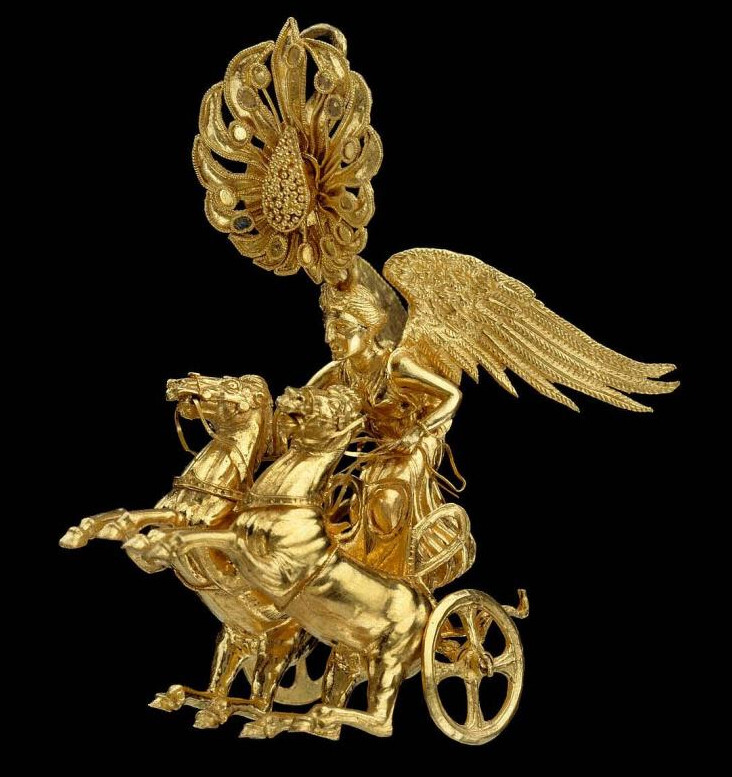
Cracked has an article about cool bling from the past, including Peruvian nose ornaments, crazy intricate Greek earrings, fancy Persian drinking cups, and Maya dental jewellery. This is your reminder that you can go super crazy with Gloranthan fashion, at least when it comes to the nobles and the priests.
Thank you for reading
That’s it for this week! Please contact us with any feedback, question, or news item we’ve missed!


